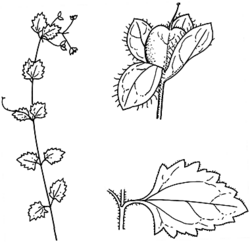Common name: Hairy Speedwell, Cup Speedwell
Veronica calycina R.Br. APNI* Synonyms: Veronica calycina var. parviflora Benth. APNI*

Description: Perennial herb with stolons to 50 cm long, rooting at nodes; flowering stems 5–45 cm high, with lateral bands of long (1–2 mm) fine simple spreading or recurved hairs and scattered hairs elsewhere.
Leaves with lamina ovate or broad-ovate, 0.7–3 cm long, 5–20 mm wide, apex rounded or broad-acute, base truncate to slightly cordate, margins with 3–13 pairs of coarse and irregular obtuse teeth; petiole 2–20 mm long.
Racemes lateral, 1.5–8 cm long, to 10-flowered or occasionally flowers solitary, racemes 1.5–8 cm long; peduncle 0–25 mm long; bracts 3–9 mm long; pedicels 3–30 mm long. Calyx lobes 6.5–8.5 mm long, 2.5–5 mm wide in fruit, ciliate. Corolla 4–6 mm long, pale blue or lilac.
Capsule broad-obovate, 2.6–5.8 mm long, 2–5.5 mm wide, emarginate, margin with dense fine erect hairs especially towards apex.
Flowering: spring–summer.
Distribution and occurrence: Grows in a range of habitats, especially eucalypt forests; widespread.
NSW subdivisions: CC, SC, NT, CT, ST, NWS, CWS
Other Australian states: Qld Vic. Tas. W.A. S.A.
Text by B. G. Briggs, B. Wiecek & A. J. Whalen
Taxon concept: Flora of NSW 3 (1992)
APNI* Provides a link to the Australian Plant Name Index (hosted by the Australian National Botanic Gardens) for comprehensive bibliographic data
***The AVH map option provides a detailed interactive Australia wide distribution map drawn from collections held by all major Australian herbaria participating in the Australian Virtual Herbarium project.
|


